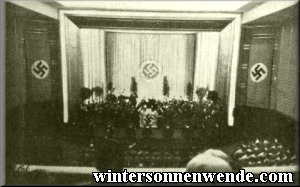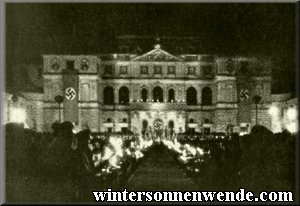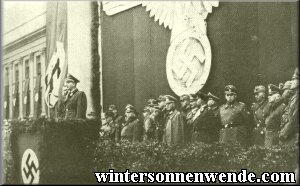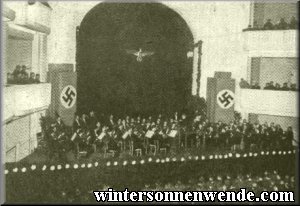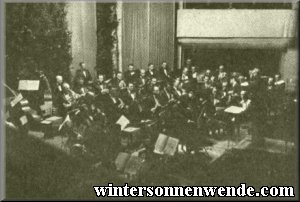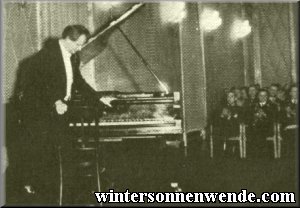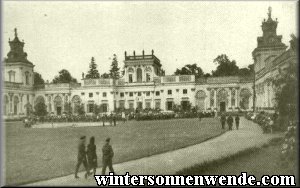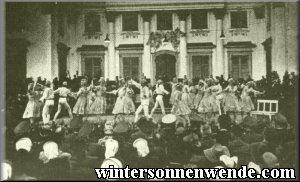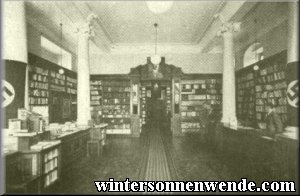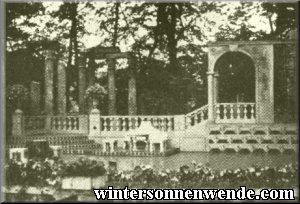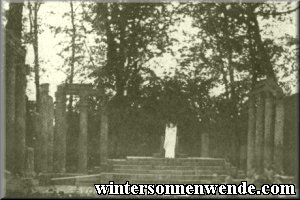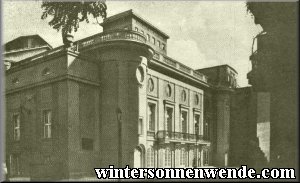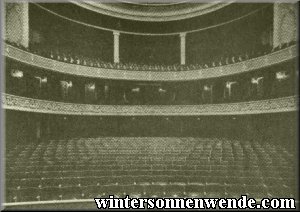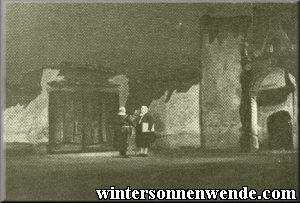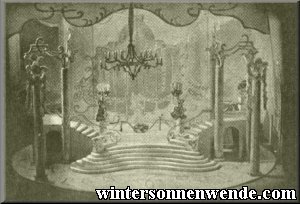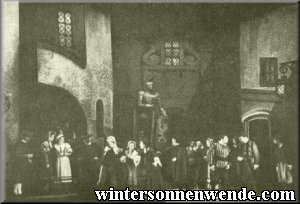 |
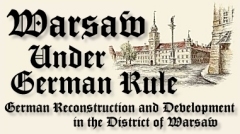 German Cultural Life in Warsaw
1. The Work of German Propaganda
Following the establishment of the General Government, these men, who had previously served in Litzmannstadt at the Reich Ministry of Propaganda's outpost for the occupied Polish territories, established the Division of Public Education and Propaganda at the offices of the District Chief in Warsaw. All the same responsibilities which the Reich Ministry of Public Education and Propaganda must discharge in the Reich were also incumbent upon these men here in the General Government. However, whereas the work of the Propaganda in the Reich is directed at people of the same racial strain, the ethnic structure of the General Government renders the conditions in this region completely different. Here, the work of the Propaganda Division is not directed only at Germans, it must also have the desired effect on Poles, Russians, Ukrainians and even Jews, and the unique mentality characterizing each individual ethnic group must be taken into account.
Beyond that, it was also necessary to monitor Polish cultural life quite closely. Before the war there had been 10 large theaters, 1 opera house, 4 operetta establishments, and other stage entertainment institutions in Warsaw. All these theaters had been destroyed in the war. The people who had been involved in their operation quite naturally wished to resume their occupations, but obviously this could not be permitted without monitoring their material, since in the past, the stage in particular had served as platform from which to spew anti-German incitement of the worst kind. The Division of Propaganda has carried out this difficult task most thoroughly. The unemployed artists whose past was found to be unobjectionable were very soon again able to work in their area of expertise. They received permits allowing them to work as singers, actors, booksellers etc. In light of the hate-mongering to which the people had been subjected in the past, it was further necessary to keep a continual watch over the programs of the reopened entertainment houses and to rid them of the products of Jewish-Marxist mentality. Particular care was devoted to active propaganda. Already in autumn 1939, political and military events had been announced to the people by means of loudspeaker vans, and in time stationary loudspeaker facilities were set up in Warsaw and the other cities of the District. A number of movie theaters for the Polish people were also gradually restored to working order. To educate the entire populace, several large-scale information campaigns were launched – the "Anti-Typhus Campaign", the "Anti-Jewish Campaign", and "Operation V", to name a few – all of which had as their goal the education of the people in the most pressing current matters. For obvious reasons no details can be divulged at this time, whether pertaining to these campaigns per se or to the very interesting insights into the intellectual attitudes of large sectors of the Polish population, gained in the course of such campaigns. The political care of the Germans was another chief responsibility of the German Division of Propaganda. The temptations which the milieu of Warsaw represents for many Germans must not be underestimated. The peculiar lure of Polish coffee-shop life has made an impression on numerous Germans. To preclude the dangers which in this respect await the Germans living in Warsaw, it was necessary to provide opportunities for other kinds of diversion and entertainment and for cultural performances of higher value. But it was equally important to provide political education for and to instil National Socialist ideology in the ethnic Germans living in the General Government who had frequently been ideologically alienated from their German heritage by their exclusively Polish surroundings. It goes without saying that the work of the Party was in the fore in all these endeavors, just as all measures in Warsaw have always been Party-oriented from the start. The German ethnic Christmas celebrations of 1939, which were held in the by now traditional meeting place "Roma House", were the first visible evidence of a truly National Socialist community. At the end of January 1940 the General Government's first mass rally took place; the speaker was Division President Frauenfeld,
Aside from this political care, it was also necessary to stimulate and entertain the German populace intellectually.
The intellectual care of the Germans residing in Warsaw was also seen to by engaging renowned German artists. Names such as Heinrich George, Wilhelm Kempff, Ellie Ney, Harald Kreuzberg, Ilse Meudtner, Margarete Teschemacher, Hilde Hildebrandt, Hans Wocke and Hans Friedrich Blunck show that intellectual and artistic performances of great caliber such as are also by no means everyday matters in the Reich were already given in Warsaw within a very short period of time. Eminent ensembles such as the Cologne Chamber Orchestra, the NS Symphony Orchestra, the Gewandhaus Quartet,
A particular high point in the cultural life of the city are the "Warsaw Days of Culture" which are held annually in September and have gained popularity far beyond the boundaries of the District. The Berlin Schiller-Theater, with Heinrich George, gave a performance in the very first Days of Culture in 1940, staging "The Judge of Zalamea". An important exhibition, "German Achievements in the Vistula Region", two concerts by the Philharmonic Orchestra of the General Government, poetry readings by Karl HeinrichWaggerl, and several broadcasts by Reich Radio Breslau show how varied and broad in scope these Days of Culture were. In 1941, the Days of Culture were again on a most ambitious scale. The festival production of Zerkaulen's "The Horseman", an evening of chamber music with the Gewandhaus Quartet of Leipzig, a poetry evening with Heinrich George, and readings by E. Wittek were some of the high points of those days. The contributions
The "Palace Concerts at Wilanow", which are to become an annual tradition, were held for the first time in 1942. These ballet and concert evenings were held in the beautiful forecourt of that magnificent palace for six summer evenings and were
Such presentations have enjoyed extensive support by the "German Cultural Association of Warsaw", established in 1942. The German Cultural Association is a society for the promotion of German cultural life and for the preservation of German monuments of culture in Warsaw. With state support, it is intended to provide financial assistance to existing cultural institutions such as the German Choir and the Symphony Orchestra of Warsaw. It will also facilitate, with financial contributions, special events which serve to maintain close ties to the cultural scene of the Reich, such as poetry readings, guest appearances by theater troupes from the Reich, exhibitions and the like. And finally, it is also intended to preserve and maintain as German cultural property the works of German architects and artisans, German painters, poets and authors, through the collection of their works and the written and pictoral analysis thereof, as well as by means of architectural maintenance where required. Numerous Germans immediately accepted the Governor's invitation to join the Cultural Association. Thanks to extensive financial donations it has already been possible to secure the financial backing required for numerous cultural events. The efforts of the Division of Propaganda have also devoted special care to German literature. As early as 1941, for example, a book exhibition titled "The Book and the Sword" was held in Warsaw in conjunction with a documentary presentation about the history of the Germans in Warsaw. This book fair was all the more important because, aside from the small libraries of the "German Club" and of the "German College Students' Association",
The Division of Propaganda has also produced some publications of its own, most notably the "Warschauer Kulturblätter" ["Warsaw Cultural Papers"] and Dr. Grundmann's "Führer durch Warschau" [="Guide to Warsaw"]. The motion picture media has been accorded a status commensurate with its great significance for the cultural care of the German populace. The most magnificent movie theater in the city, which had been renamed "Helgoland", was the first such institution to be made available to the Germans, opening its doors as early as December 1939. Two other movie theaters were soon also put into operation solely for the Germans, and screened the cream of the German movie crop only very shortly after their first showings. Movies also brightened the winter months for the Wehrmacht. The Division of Propaganda's movie vans braved adverse weather and the worst conceivable road conditions to reach the remote troop accommodations, where they brought much joy to the soldiers. The entertainment and intellectual care of the troops has been one of Propaganda's most important responsibilities. Thousand of valuable books have been provided to the Wehrmacht, and special events have also been put on for entertainment purposes. A soccer game with Team Schalke 04, which more than 20,000 soldiers attended, and a major boxing tournament with well-known professional German boxers including Max Schmeling,** no less deserve mention in this context than does the first Greater German Chess Tournament in the General Government, among whose participants were the world champion Aljechin and the former German champion Bogoljubow. The intellectual care of the wounded was, of course, of paramount importance. Larger numbers of wounded have always been given a guest reception at all cultural events. This extensive attention devoted to the Germans is completely in line with our overall policy, which attaches a completely different significance to the German East than had used to be the case. In the past, a transfer to the East had frequently been considered punishment, since the concept of "the East" involuntarily conjures up false images of a lack of culture, which owe their existence to misleading propagandistic allegations of cultural inferiority of the Reich's Eastern territories. This misconception must be dispelled once and for all. And in a very few years it will indeed be a relic of the past; for the many opportunities for cultural activity and the enjoyment of cultural assets which have been created here in the East will soon disprove this once widely-held belief.
 2. German Theater in Warsaw Anyone familiar with the history of the theater in Warsaw knows that German theater has always been important in Poland. Performances of the dramas of Lessing – "Emilia Galotti" and "Minna von Barnhelm", for example – were already given in Radziwill Palace, today's "German House", in the late 18th century, and names such as Goethe and Schiller have also made more than a merely transitory appearance in the history of Warsaw theater. However, in the Polish Republic created by the dictates of Versailles, German theater was no longer accorded its previous significance; Poland looked mainly to Paris for inspiration, as that city was regarded by the Poles as the embodiment of utmost artistic perfection. As a result, with the exception of small circles of aficionados, German theater in Warsaw largely ceased to exist during the 20 years' existence of the Polish Republic. It was thus very difficult to renew creative efforts in this field, since there was no existing tradition to take up. Nevertheless, German theater quickly sprung up again in Warsaw as well as throughout the General Government, and travelling stages advanced to the battle front immediately after the cease of hostilities in the District of Warsaw, hard on the heels of the tanks and cannons. The names of Dreher, Oberland, Pless etc. still have meaning for any German soldier who was stationed in Poland in those early days; everyone still fondly remembers these travelling war-front stages because these were the first emissaries of culture which brought the welcome words of home to the German soldiers laboring in an alien environment, and thus brought them enjoyment and relaxation. But these presentations were few and far between. The ultimate goal was to establish a German theater facility so as to have a permanent cultural center where German literature would find daily expression. The men who acted as the General Government's pioneers in this area were Senior Administrative Councilor Ohlenbusch, then Head of the Division of Propaganda for the District of Warsaw and later Head of the Main Division of Propaganda for the General Government, and
Not far from Lazienki Castle, one of the most beautiful buildings in Warsaw, Polish kings had once had German architects construct an outdoor theater patterned on the ancient theater of Herculaneum. This old stage in Belvedere Park was restored to new life. Here, in the capital of the former Polish Republic, German actors spoke Goethe's immortal verses of "Iphigenie auf Tauris" to a German audience, performed Calderon's "Loud Secret" and Tirso de Molina's "Don Gil of the Breeches Green", and delighted with their presentations the thousands of spectators who were so lucky as to witness the unforgettable sight of a theater presentation in Belvedere Park during those summer evenings.
The former "Teatr Polski", which had sustained only minor damage during the war, had been renovated and turned into this new theater, which was officially opened with a performance of Friedrich Hebbel's "Agnes Bernauer" in the presence of the Governor General himself. That very same month also saw a guest performance by Heinrich George and the Schiller Theater of Berlin, who treated the Germans to a brilliant production of "The Judge of Zalamea". Shortly after that, the first Philharmonic Hall was inaugurated with performances of immortal works by Bach, Beethoven, Brahms and other great German men of musical genius, presented under the conductorship of Dr. Hans Rohr. The guest performance by the Royal Opera Vitorio Emanuele of Florence, which presented an exquisite rendering of Cimarosa's opera "The Clandestine Marriage", must also be mentioned in this context. The work of the Theater of Warsaw, with its own ensemble, began after these guest performances. Altogether 187 German performances were held in front of German audiences during the season of 1940–41. Some of the works presented included:
"Der Vetter aus Dingsda" [="The Cousin From What's-its-Name"], operetta by Ed. Kunnecke; "Die Fledermaus" [ = "The Bat"], operetta by Johann Strauss; "Das Hahnenei" [="The Rooster's Egg"], comedy by Hans Fritz; "Donna Diana", comedy by Don Augustin Moreta; "Drei alte Schachteln" [="Three Old Women"], operetta by Walter Kollo; "Kleine Parfumerie" [="The Little Perfumery"], comedy by Leo Lenz; "Die Primanerin" [="The High School Senior"], comedy by Siegmunt Graff; "Die lustige Witwe" [ = "The Merry Widow"], operetta by Franz Lehar; "Die Frau ohne Kuss" [ = "The Unkissed Woman"], comedy musical by Walter Kollo; "Marguerite: 3", comedy by Fritz Schwifert.
Incidentally, the Theater of Warsaw does not perform only for Germans. Several evenings each week there are strictly Polish performances in which Polish actors perform for Polish audiences. It would be premature at this point to pass final judgement on the Theater of Warsaw's work; it is as yet only being directed out of its infancy by theater manager Franz Nelkel. The same artistic niveau which a sophisticated theater audience is used to from performances on the great stages in Berlin, Munich or other German theater cities can clearly not be expected here. It would be unfair to apply the same standards of judgement. But the fact that a German theater which almost nightly imparts the cultural treasures of home to an appreciative German public could be established here at all, and especially in the midst of the greatest war of our century, is one thing which must be universally acknowledged with respect. The old saying that war silences the Muses no longer holds true in Germany today. German theater rising anew in Warsaw and throughout the entire General Government is the best possible proof of that.
 *[Trans. note:] Head of an administrative district ("Gau") of the German Reich. ..back...
**[Trans. note:] Max Schmeling was the German Lightheavyweight Champion
1926–1928, European Lightheavyweight Champion
1927–1928, German Heavyweight Champion 1928, World Heavyweight Champion
1930–1932, and European Heavyweight Champion
1939–1943. ...back...
|





